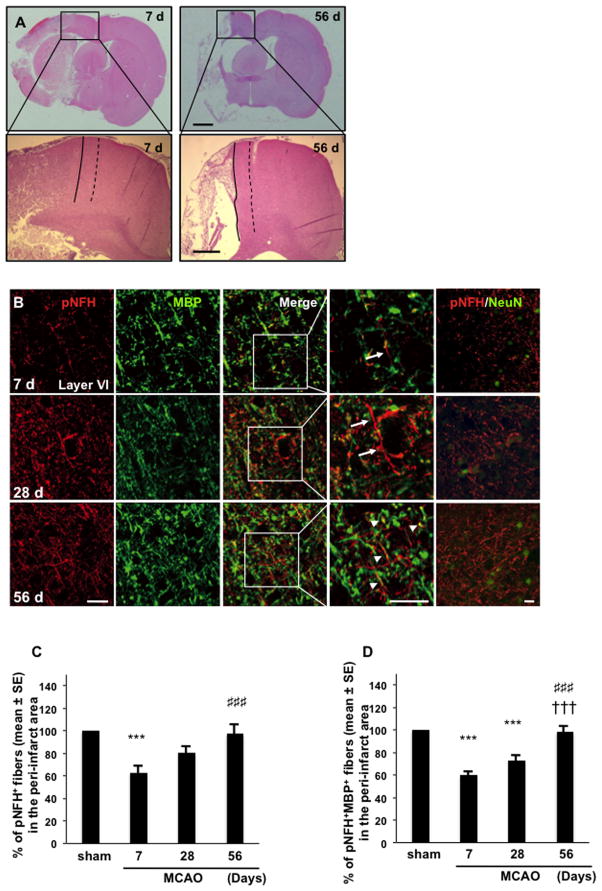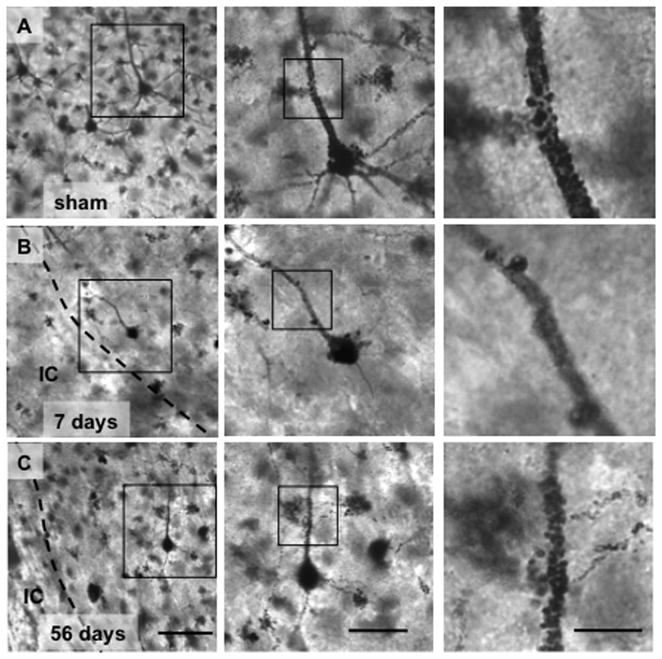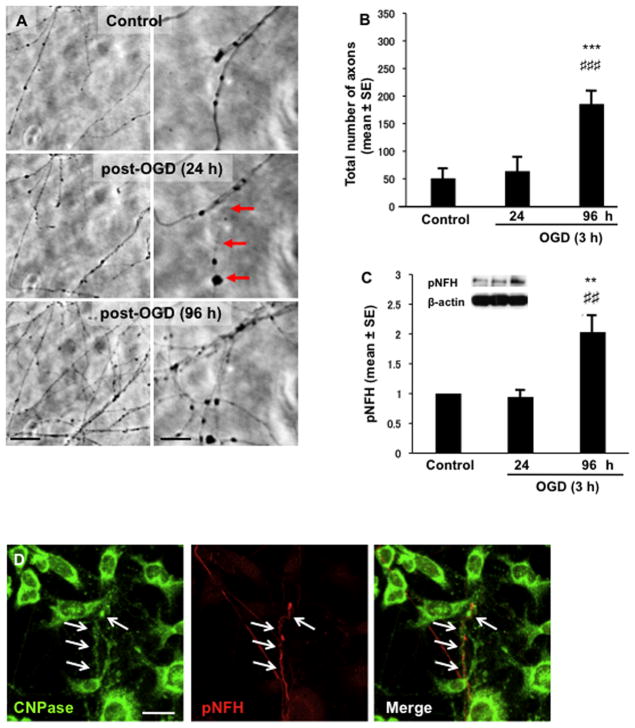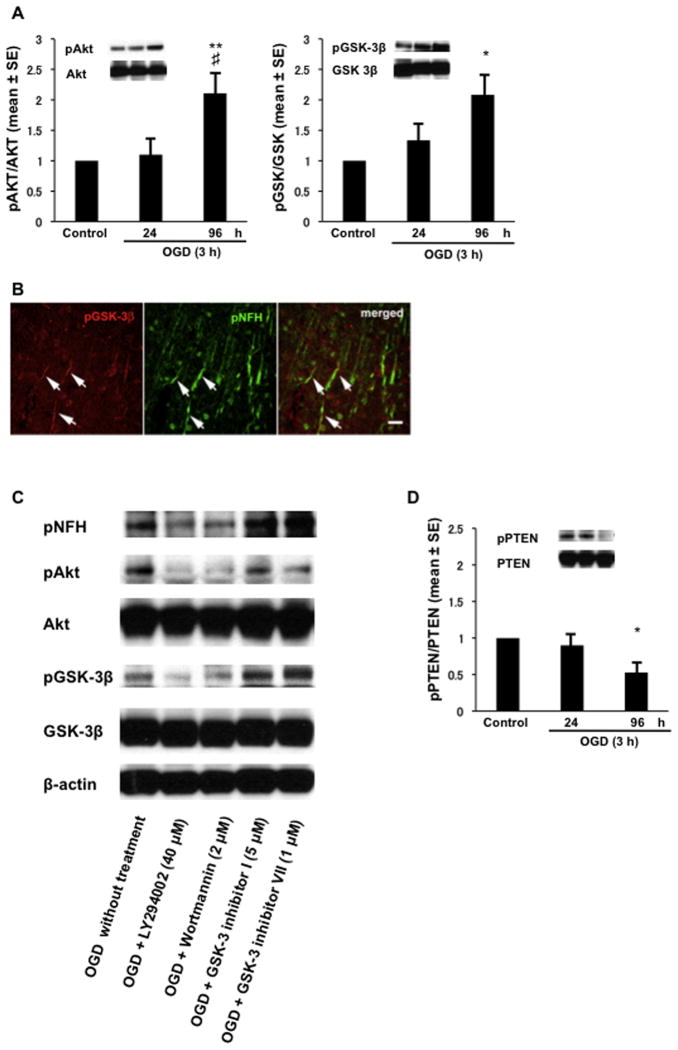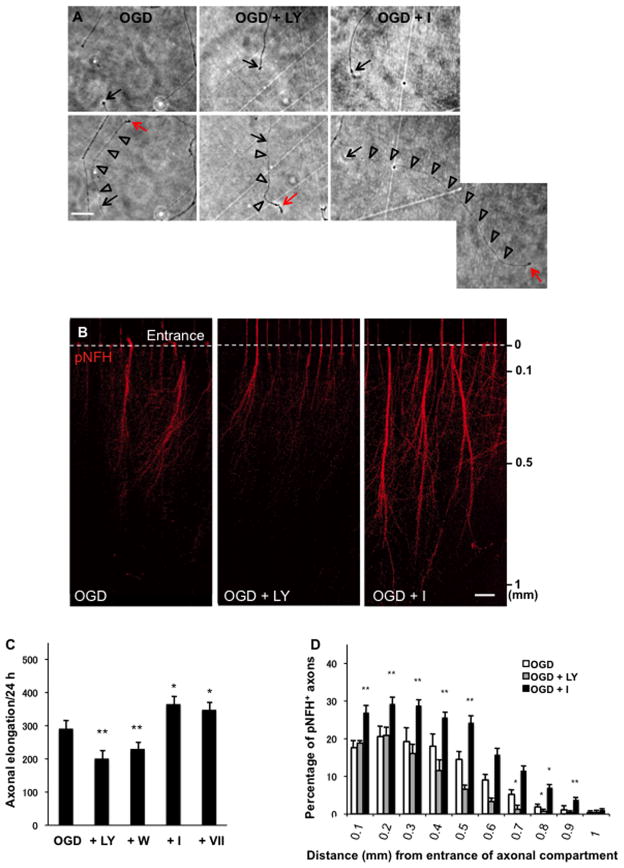Abstract
Background and Purpose
Axonal remodeling is critical to brain repair after stroke. The present study investigated axonal outgrowth after stroke and the signaling pathways mediating axonal outgrowth in cortical neurons.
Methods
Using a rodent model of middle cerebral artery occlusion, we examined high molecular weight neurofilament (NFH) immunoreactive axons and myelin basic protein (MBP) positive oligodendrocytes in the peri-infarct area. In vitro, using cultured cortical neurons in a microfluidic chamber challenged by oxygen-glucose deprivation (OGD), we investigated mechanisms selectively regulating axonal outgrowth after OGD.
Results
NFH+ axons and MBP+ oligodendrocytes substantially increased in the peri-infarct area during stroke recovery, concomitantly with an increase in dendrites and spines identified by Golgi-Cox staining. In vitro, cortical neurons subjected to OGD exhibited significant increases in axonal outgrowth and in phosphorylated NFH protein levels, concurrently with downregulation of phosphatase tensin homolog deleted on chromosome 10 (PTEN), activation of Akt, and inactivation of glycogen synthase kinase-3β(GSK-3β) in regenerated axons. Blockage of phosphoinositide 3-kinase (PI3K) with pharmacological inhibitors suppressed Akt activation and attenuated phosphorylation of GSK-3β, which resulted in suppression of pNFH and axonal outgrowth after OGD, whereas GSK-3 inhibitors augmented axonal regeneration and elevated pNFH levels after OGD.
Conclusions
Stroke induces axonal outgrowth and myelination in rodent ischemic brain during stroke recovery, and the PI3K/Akt/GSK-3β signaling pathway mediates axonal regeneration of cortical neurons after OGD.
Keywords: Stroke, Axonal outgrowth, High molecular weight neurofilament, GSK-3β, Akt
Introduction
Brain injury including stroke induces limited axonal regrowth. Emerging data indicate that axonal remodeling is a critical aspect of brain repair and contributes to spontaneous improvements of neurological deficits after stroke.1.2
Neurofilament (NF), a neuron-specific intermediate filament, is the most abundant architectural cytoskeletal element in axons and dendrites.3 Neurofilaments are composed of three different subunits, light (68kDa), medium (150 kDa), and heavy (NFH, 200 kDa).3 The activity of NF depends on its state of phosphorylation.4 Phosphorylated NFH (pNFH) participates in axonal growth and regulates synaptic function.5.6 Several articles have suggested that aberrant perikaryal accumulation of hyperphosphorylated NFH in neurodegenerative disorders.7.8 Non-phosphorylated NFH (npNFH) is also described as being more abundant in regenerating axons of injured nerve, whereas npNFH indicates damaged and demyelinated axons in multiple sclerosis.9.10 Until recently, only a few studies have examined changes in pNFH after stroke. Stroke induces pNFH in perikarya of injured neurons in human brain.11 In the rodent, cortical infarct results in reduction of pNFH within the peri-infarct region.12 Mechanisms that regulate axonal regrowth and phosphorylation of NFH after stroke have not been fully investigated.
In the present study, we analyzed the profiles of axonal outgrowth and myelination in rat ischemic brains. We also investigated axonal outgrowth and the signaling pathways that mediate axonal outgrowth in cultured cortical neurons.
Methods
All experimental procedures were approved by the Institutional Animal Care and Use Committee of Henry Ford Hospital.
Focal cerebral ischemia
Adult male Wistar rats (~350g, Charles River, Wilmington, MA) were subjected to permanent right middle cerebral artery occlusion (MCAO) by advancing a 4–0 surgical nylon suture with an expanded tip.2.13 Rats were sacrificed at 7, 28 or 56 days after MCAO. Peri-infarct area in cerebral cortex of the rat was defined on Hematoxylin and Eosin (H&E) stained coronal sections (8 μm) as the area encompassed by a 300 μm distance from the infarction.14
Primary cortical neurons
Cortical neurons were harvested from embryonic day-17 Wistar rats (Charles River), according to a published protocol. To separate axons from neuronal soma, a microfluidic chamber (Standard Neuron Device, Xona Microfluidics, Temecula, CA) was employed.15 Oxygen-glucose deprivation (OGD) was performed for 3 h. Please see supplemental methods.
Co-culture of neurons with oligodendrocyte cells
Standard co-culture system was employed according to published protocols. Briefly, mouse premature oligodendrocyte cells (N20.1, generously provided by Dr. Anthony Campagnoni, University of California at Los Angeles) were incubated in DMEM/F12 at 39°C for 9 days.13 Please see supplemental methods.
Experimental protocol
To examine the effect of Akt or (glycogen synthase kinase-3β) GSK-3β on axonal outgrowth and pNFH expression after ischemia, neurons were treated with pharmacological phosphoinositide 3-kinase (PI3K) inhibitors, LY294002 (2-(4-morpholinyl)-8-phenyl-4H-1-benzopyran-4-one, 10, 20, and 40 μM; Calbiochem, San Diego, CA) and Wortmannin (2 μM; Calbiochem), or GSK-3 inhibitors, inhibitor I (TDZD-8, Thiadiazolidinone analog, 5 μM; Calbiochem) and inhibitor VII (α-4-dibromoacetophenone, 1 μM; Calbiochem) for 96 h after OGD.16–18
Immunohisto and immunocytochemistry
Single and double immunofluorescent staining was performed on brain sections and cultured cells, as previously described.16 Please see supplemental methods.
Golgi-Cox staining
Golgi-Cox staining was performed on brain tissue according to a protocol kindly provided by Dr. Crystal L. MacLellan.19
Image acquisition and quantification
For histological study, three coronal sections at 200 μm intervals per rat per staining were used. Three images of peri-infarct area in cerebral cortex per section were acquired using a 2-photon microscope (Zeiss LSM 510 NLO, Germany) under a 40× objective. Images were analyzed using the NIH Image analysis program version 1.43, as described previously.20 Please see supplemental methods.
Western Blot
Western blots were performed according to published methods.16 Please see supplemental methods.
Real-Time Reverse Transcriptase-Polymerase Chain Reaction
Quantitative RT-PCR was performed on an ABI 7000 PCR instrument (Applied Biosystems, Foster City, CA) using SYBR Green real-time PCR method.16 Please see supplemental methods.
Time-lapse microscopy
Axons cultured in microfluidic chamber were incubated in a stage top chamber with 5% CO2 at 37°C, which was placed on the stage of a TE2000-U inverted microscope equipped with a motorized z-stage (Nikon, Tokyo, Japan). Please see supplemental methods.
Statistical analysis
All statistical analyses were performed using the Statistical Package for the Social Sciences SPSS (version 15; SPSS Inc, Chicago, IL). Student’s t test and One-way ANOVA with post hoc Bonferroni were used when comparing two groups and more than two groups, respectively. Values presented in this study are expressed as mean ± standard error. A P-value < 0.05 was considered significant.
Results
NFH immunoreactivity in experimental stroke
Neurons express pNFH and npNFH in their axons and dendrites.5 We found that pNFH immunoreactive neuronal fibers were closely associated with myelin basic protein (MBP, a marker of myelinating oligodendrocytes) immunoreactive processes in the cortical layer of sham-operated rats (Supplemental Figure S1A), and that approximately, 70% of pNFH+ fibers were associated with MBP in layer VI (Supplemental Figure S1A), suggesting that the majority of pNFH+ fibers are myelinated axons. The npNFH+ fibers were also adjacent to MBP+ processes in layer VI, although npNFH were expressed in neuronal soma and apical dendrites in layer II to V (Supplemental Figure S1B). The pNFH+ axons, and npNFH+ axon, soma and dendrites substantially decreased in axonal and somal compartments in the peri-infarct area after stroke (Supplemental Figure S2A). In layer VI of rat cerebral cortex, MCAO resulted in a well demarcated infarction in the territory supplied by the MCA during 7 to 56 days post stroke (Figure 1A). We measured pNFH immunoreactive fibers in the peri-infarct area (Figure 1A) and found a significant reduction of pNFH+ fibers of up to 63 % at 7 days of MCAO in the peri-infarct area compared to homologous areas of sham-operated rats (Figure 1B. C). However, pNFH+ fibers in the peri-infarct area increased to 81% and 97 % of intact levels at 28 and 56 days after MCAO, respectively (Figure 1B. C). Moreover, the number of NeuN+ cells in the area did not significantly change during this period (Figure 1B). Interestingly, in the contralateral cortex, pNFH+ fibers substantially decreased to 68 % at 7 days after MCAO compared to sham-operated rats, and increased to 79 and 95 % of intact levels at 28 and 56 days after MCAO, respectively (Supplemental Figure S2B). In addition, at 7 days of MCAO, pNFH+ fibers associated with MBP+ processes were reduced by 60 % in the peri-infarct area compared to homologous areas of sham-operated rats (Figure 1B, D), while at 56 days after MCAO pNFH+ fibers surrounded by MBP immunoreactivity increased to 98 % of intact levels, which is equivalent to the levels of pNFH and MBP in sham-operated rats (Figure 1B, D). A comparable profile of npNFH immunoreactive fibers was also detected (Supplemental Figure S2C, S3A-C). These data suggest that myelinated axons are increased in the peri-infarct area during stroke recovery.
Figure 1. Distribution of pNFH+ and MBP+ fibers in the peri-infarct cortical region.
Panel A is images of brain coronal sections stained with H&E from representative rats, showing infarction at 7 days and cavitation at 56 days after MCAO as outlined by a solid line as well as peri-infarct area indicated by a dotted line (300 μm apart from the solid line). Panel B is double immunofluorescent confocal images of representative rats at 7, 28 and 56 days after MCAO, showing pNFH+ and MBP+ fibers as well as pNFH+ fibers and NeuN+ cells. Arrows and arrowheads indicate that pNFH+ axons were not associated and closely associated, respectively, with MBP+ processes in the peri-infarct areas. Panel C is quantitative data of pNFH+ axons in the ipsilateral peri-infarct area. Panel D is quantitative data of pNFH+ axons closely associated with MBP+ processes in the peri-infarct area. N=4/group. Values are mean ± SE. ***P < 0.001 vs sham group; ###P < 0.001 vs the 7 day group; †††P < 0.001 vs the 28 day group. Scale bars: 2 mm in A; 500 μm in A (magnified images); 20 μm in B.
Axonal outgrowth is closely related to growth of dendrites and dendritic spines.21 At 7 days following MCAO, Golgi-Cox staining indicated that neurons showed a marked deterioration of basilar dendrites with connection to adjacent neurons, and dramatic reduction of the number and diameter of dendrites, and spine number of apical dendrites compared to neurons in sham-operated rats (Figure 2A, B). Moreover, swollen dendritic spines increased (Figure 2B, Supplemental Figure S4A). However, numbers of spines in apical dendrites significantly increased at 56 days compared to 7 days after MCAO (Figure 2C, Supplemental Figure S4B). These dendrites increased in number and length and they connected to dendrites derived from adjacent neurons (Figure 2C, Supplemental Figure S4C, D), whereas only scattered swollen spines were present (Supplemental Figure S4A).
Figure 2. Morphological alteration of dendrites and dendritic spines after MCAO in the rat.
Panels A, B, C are microscopic images of cortical pyramidal neurons stained with Golgi-Cox staining from representative rats, showing dendritic and spine morphologies in sham-operated rat (A), rats at 7 (B), and 56 days (C) after MCAO at different magnifications. 50 μm, 20 μm, and 10 μm on each panel C.
pNFH in cultured cortical neurons
Aforementioned in vivo data suggest that regeneration of axons occurs in the peri-infarct area. To directly examine axonal regeneration and sprouting, we employed a microfluidic chamber, which separates axons from neuronal cell bodies and permits direct axonal outgrowth monitoring in cortical neurons.15 Cortical neurons cultured in a microfluidic chamber exhibited axonal morphology (Figure 3A). OGD for 3 h did not significantly increase caspase-3 levels in cortical neurons (Supplemental Figure S5A), but induced damaged axons with beaded and vanishing appearance at 24 h (Figure 3A, Supplemental Figure S5B). However, 96 h after OGD, a large number of axons were regenerated (Figure 3A, B). RT-PCR and Western blot analysis showed that mRNA levels of NEFH and protein levels of pNFH substantially increased at 96 h compared with 24 h after OGD as well as control non-OGD neurons (Figure 3C, Supplemental Figure S5C). To examine whether these axons can be myelinated, we co-cultured axons with differentiated N20.1 cells in the axonal compartment of the microfluidic chamber. Double immunostaining revealed that many pNFH+ axons were surrounded by 2′, 3′-cyclic nucleotide 3′-phosphodiesterase+ (CNPase+) oligodendrocyte processes at 96 h after OGD (Figure 3D). Collectively, these data suggest that OGD induces axonal regeneration and sprouting, and newly generated axons can be myelinated by oligodendrocytes in vitro.
Figure 3. Axonal outgrowth and myelination after OGD in primary cortical neuronal cultures.
Panels A is representative time-lapse microscopic images of primary cortical neuronal culture in a microfluidic chamber, showing morphological changes of axons before OGD, and at 24 h and at 96 h after OGD. Red arrows indicate damaged axon with a beaded appearance. Panels B is quantitative data of total number of axons before OGD, and at 24 and 96h after OGD. N=4/group. Panel C shows pNFH protein levels measured by Western blots. N=5/group. Panel D is double immunofluorescent confocal images of cocultured primary cortical neurons and differentiated N20.1 cells, showing a pNFH+ axon (red) was spirally wrapped by CNPase process (arrow, green). Values are mean ± SE. **P < 0.01 vs the control; ***P < 0.001 vs the control; ##P < .01 vs the 24 h group; ###P < 0.001 vs the 24 h group. 40 μm and 20 μm on each panel A.
Phosphorylation of GSK-3β enhances pNFH and axonal growth
Several signaling pathways including PI3K/Akt signaling mediate growth of axonal and dendritic branches.22 Western blot analysis showed a significant increase in pAkt in neurons at 96 h after OGD compared to neurons without OGD, which was coincident with elevation of pGSK-3β Ser9 (Figure 4A). These data suggest that the activation of PI3K/Akt phosphorylates GSK-3β at Ser9. To examine whether stroke induces pGSK-3β, we performed immunostaining on brain coronal sections. Double immunofluorescent staining revealed that pNFH+ processes in peri-infarct areas were pGSK-3β+ (Figure 4B), suggesting activation of inhibitory GSK-3β in vivo. To further examine the connection between PI3K/Akt activity and phosphorylation of GSK-3β, we treated neurons subjected to OGD with PI3K inhibitors, LY294002 and Wortmannin;16.17 both inhibitors significantly decreased pAkt, and reduced pGSK-3β Ser9 (Figure 4C, Supplemental Figure S6B, C). To test whether the increases in the levels of pGSK-3β that inactivate GSK-3β are functionally relevant to elevated pNFH, we blocked GSK-3β activity using two structurally unrelated non-ATP competitive GSK-3β inhibitors, inhibitor I and VII.18 Treatment of OGD-challenged neurons with both GSK-3β inhibitors further elevated pGSK-3β Ser9 and pNFH, whereas PI3K inhibitors substantially decreased pNFH protein levels (Figure 4C, Supplemental Figure S6A, C). In parallel, time-lapse microscopy revealed that inhibition of GSK-3β activation by GSK-3 inhibitor I increased axonal elongation (Figure 5A, C) and pNFH+ arborization (Figure 5B, D). In contrast, a PI3K inhibitor, LY294002 significantly suppressed axonal outgrowth (Figure 5A, C) and pNFH+ arborization (Figure 5B, D).
Figure 4. Phosphorylation of PTEN, Akt, and GSK-3β in cortical neurons after OGD.
Panels A is Western blot data, showing that pAkt (Ser 473, A), and pGSK-3β (Ser 9, B). Total Akt, and GSK-3β levels were used as internal controls. Panel B is confocal images of double immunofluorescent staining showing that pGSK-3β+ fibers (red) were pNFH+ (green) in peri-infarct area of a representative rat 28 days after stroke. Scale bars: 20 μm. Panel C is representative Western blots showing protein levels of pNFH, pAkt, and pGSK-3β after treatment with PI3K inhibitors, LY294002 (40 μM, LY) and Wortmannin (2 μM, W), or GSK-3 inhibitor I (5 μM, I) or VII (1 μM, VII). Total Akt, GSK-3β and β actin were used as internal controls. Panels D is Western blot data, showing pPTEN (Ser 380/Thr 382/383, C). Total PTEN levels was used as internal controls. N=5/group. Values are mean ± SE. *P < 0.05 vs the control; ** P < 0.01 vs the control; #P < 0.05 vs the 24 h group.
Figure 5. Effects of Akt and GSK-3 inhibitors on axonal elongation and arborization in OGD-challenged primary cortical neurons.
Panel A is representative time-lapse microscopic images of primary cortical neuronal culture in a microfluidic chamber, showing axonal outgrowth (lower images, arrowhead) from a starting point at 24 h (upper images, black arrow) to ending point at 48 h (lower images, red arrow) in OGD-challenged neurons without any treatment (left), with LY294002 treatment (middle), or with GSK-3 inhibitor I treatment (right). Panel B is confocal tiling images of pNFH+ axons of primary cortical neurons cultured in microfluidic chambers at 96 h after OGD without treatment (left), LY294002 treatment (middle), or GSK-3 inhibitor I (right). Panel C is quantitative data of axonal elongation after treatment with PI3K inhibitors LY294002 (LY) and Wortmannin (W) or GSK-3 inhibitor I (I) and VII (VII) in OGD challenged neurons. Panel D is quantitative data of percentage of pNFH positive axons that distended from the entrance of axonal compartments (B, dot lines) in at 96 after OGD without treatment, with treatment of LY294002 (LY) or GSK-3 inhibitor I (I). N=3/group. Values are mean ± SE. *P < 0.05 vs the OGD without treatment group; **P < 0.01 vs the OGD without treatment group. Scale bars: 50 μm in A;100 μm in B.
LY294002 (40 μM) did not significantly induce cell death measured by TUNEL positive cells (Supplemental Table 1), and did not significantly increase the number of damaged axons compared to neurons without treatment after OGD (Supplemental Figure S6D). Consistent with concentration of 40 μM, we found that LY294002 at 10 and 20 μM significantly (p<0.01) blocked axonal elongation by 30 and 43 %, respectively, (n=80 axons/group) compared to the control group (n=70 axons/group).
Phosphatase tensin homolog deleted on chromosome 10 (PTEN) inhibits Akt activity and mediates axonal outgrowth.23 Cyclin-dependent kinase (cdk5) regulates axonal transport and phosphorylates NFH.24 Axons at 96 h after OGD exhibited a substantial reduction of phosphorylated PTEN (Figure 4D), but levels of total and phosphorylated cdk5 did not significantly change compared with the levels in the control group (data not shown), suggesting that downregulation of PTEN activates Akt, while cdk5 may not play an important role in OGD-elevated pNFH. Collectively, our data suggest that inactivation of GSK-3β by its phosphorylation at Ser9 enhances axonal outgrowth via the PI3/Akt pathway in OGD challenged neurons.
Discussion
The present study demonstrates that in rodent ischemic brain, stroke substantially increased NFH+ axons in peri-infarct cortex and in homologous areas of the contralateral cortex during the recovery period and increased NFH+ axons were closely associated with myelinating oligodendrocytes. Moreover, in vitro data show that inhibition of GSK-3β elevated pNFH levels and enhanced axonal outgrowth of the cortical neurons challenged by OGD via the PI3/Akt pathway. These data suggest that the PI3K/Akt/GSK-3β signaling pathway could be a potential therapeutic target for promoting axonal regrowth after stroke.
Stroke acutely causes a loss of pNFH+ axons in mammals.12 In human brains after stroke, pNFH accumulates in perikarya and dendrites.11 However, little information is available on the distribution of pNFH+ axons in ischemic brain during stroke recovery. Our experimental data revealed that acute stroke induced loss in NFH+ axons. More importantly, we found gradual, but substantial increases in NFH+ axons in the peri-infarct cortex and many of these axons were surrounded by MBP+ processes during stroke recovery, suggesting that stroke induces axonal regrowth and newly generated axons are myelinated. Likewise, in the contralateral cortex, we detected a substantial reduction and subsequent increase of pNFH+ axons in acute stroke and recovery from stroke, respectively. This finding is consistent with recently published studies showing an increase in axonal outgrowth in the contralateral cortex during stroke recovery in the rodent which was facilitated by treatment with inosine or bone marrow stromal cells.2.25
A major challenge for studying axonal outgrowth of cultured cortical neurons is the need to isolate axons from other cellular debris, which impedes investigation of mechanisms underlying axonal outgrowth. We employed a recently developed microfluidic platform that isolates axons from dendrites of cortical neurons.15 We demonstrated that cortical neurons injured by OGD have elevated pNFH levels and regenerate axons, which was associated with increases in phosphorylation of GSK-3β. Moreover, inhibition of GSK-3β with pharmacological inhibitors increased phosphorylation of GSK-3β and pNFH and promoted axonal regeneration and arborization. Phosphorylation of GSK-3β inactivates GSK-3β.26 GSK-3β acts as a negative regulator of axon formation.27 Phosphorylated GSK-3β has been implicated in the phosphorylation of NFH,28 since GSK-3β has affinity to the NFH side arm.29 Thus, our data for the first time indicate that in cortical neurons, pGSK-3β mediates pNFH expression and axonal regeneration after OGD. However, in addition to neurons, GSK-3β plays important roles in brain parenchymal cells including neural stem cells. Administration of GSK-3β inhibitors will not selectively block neuronal GSK-3β activity in vivo. Investigation of the role of GSK-3β in axonal outgrowth after stroke by use of a conditional GSK-3β mouse (Gsk-3βflox/flox) to create mice with neuron-specific GSK-3β deficiency, is warranted.
PI3K activates Akt.22 Upon activation, Akt phosphorylates diverse substrates including GSK-3β.22 PTEN inhibits PI3K/AKT signaling.27 Activation of Akt and subsequent phosphorylatory inhibition of GSK-3β increases axonal outgrowth of dorsal root ganglial neurons.30 The present study demonstrates that elevation of pNFH in cortical axons was associated with downregulation of PTEN and activation of Akt, whereas inhibition of PI3K suppressed Akt activation and downregulated phosphorylation of GSK-3β. Therefore, our data indicate that reduction of PTEN activates PI3K/Akt signaling, which in turn inhibits GSK-3β by its phosphorylation, leading to axonal outgrowth of cortical neurons after OGD. A caveat is that, these in vitro findings can not be directly applied to in vivo observation, 31 However, our in vivo immunohistochemistry data suggest the activation of inhibitory GSK-3β in pNFH fibers in the peri-infarct area. Others have demonstrated that deletion of PTEN enhances regeneration of adult corticospinal tract in mouse model of spinal cord injury.23 Therefore, inhibition of GSK-3β activity in axons has a potential therapeutic effect to enhance axonal generation in the adult injured brain after stroke.
Supplementary Material
Acknowledgments
The authors wish to thank Qinge Lu and Supata Santra for technical assistance.
Funding
This work was supported by the National Institutes of Health (PO1 NS23393, RO1 AG037506, and RO1 NS75156).
Footnotes
Conflict of interest: None
References
- 1.Li S, Overman JJ, Katsman D, Kozlov SV, Donnelly CJ, Twiss JL, et al. An age-related sprouting transcriptome provides molecular control of axonal sprouting after stroke. Nat Neurosci. 2010;13:1496–1504. doi: 10.1038/nn.2674. [DOI] [PMC free article] [PubMed] [Google Scholar]
- 2.Liu Z, Li Y, Zhang ZG, Cui X, Cui Y, Lu M, et al. Bone marrow stromal cells enhance inter- and intracortical axonal connections after ischemic stroke in adult rats. J Cereb Blood Flow Metab. 2010;30:1288–1295. doi: 10.1038/jcbfm.2010.8. [DOI] [PMC free article] [PubMed] [Google Scholar]
- 3.Hirokawa N. Cross-linker system between neurofilaments, microtubules, and membranous organelles in frog axons revealed by the quick-freeze, deep-etching method. J Cell Biol. 1982;94:129–142. doi: 10.1083/jcb.94.1.129. [DOI] [PMC free article] [PubMed] [Google Scholar]
- 4.Julien JP, Mushynski WE. Multiple phosphorylation sites in mammalian neurofilament polypeptides. J Biol Chem. 1982;257:10467–10470. [PubMed] [Google Scholar]
- 5.de Waegh SM, Lee VM, Brady ST. Local modulation of neurofilament phosphorylation, axonal caliber, and slow axonal transport by myelinating schwann cells. Cell. 1992;68:451–463. doi: 10.1016/0092-8674(92)90183-d. [DOI] [PubMed] [Google Scholar]
- 6.Sanchez I, Hassinger L, Sihag RK, Cleveland DW, Mohan P, Nixon RA. Local control of neurofilament accumulation during radial growth of myelinating axons in vivo. Selective role of site-specific phosphorylation. J Cell Biol. 2000;151:1013–1024. doi: 10.1083/jcb.151.5.1013. [DOI] [PMC free article] [PubMed] [Google Scholar]
- 7.Sternberger NH, Sternberger LA, Ulrich J. Aberrant neurofilament phosphorylation in alzheimer disease. Proc Natl Acad Sci U S A. 1985;82:4274–4276. doi: 10.1073/pnas.82.12.4274. [DOI] [PMC free article] [PubMed] [Google Scholar]
- 8.Goldman JE, Yen SH. Cytoskeletal protein abnormalities in neurodegenerative diseases. Ann Neurol. 1986;19:209–223. doi: 10.1002/ana.410190302. [DOI] [PubMed] [Google Scholar]
- 9.Mahad DJ, Ziabreva I, Campbell G, Lax N, White K, Hanson PS, et al. Mitochondrial changes within axons in multiple sclerosis. Brain. 2009;132:1161–1174. doi: 10.1093/brain/awp046. [DOI] [PMC free article] [PubMed] [Google Scholar]
- 10.Tsuda M, Tashiro T, Komiya Y. Selective solubilization of high-molecular-mass neurofilament subunit during nerve regeneration. J Neurochem. 2000;74:860–868. doi: 10.1046/j.1471-4159.2000.740860.x. [DOI] [PubMed] [Google Scholar]
- 11.Hedreen JC, Koliatsos VE. Phosphorylated neurofilaments in neuronal perikarya and dendrites in human brain following axonal damage. J Neuropathol Exp Neurol. 1994;53:663–671. doi: 10.1097/00005072-199411000-00013. [DOI] [PubMed] [Google Scholar]
- 12.Bidmon HJ, Jancsik V, Schleicher A, Hagemann G, Witte OW, Woodhams P, et al. Structural alterations and changes in cytoskeletal proteins and proteoglycans after focal cortical ischemia. Neuroscience. 1998;82:397–420. doi: 10.1016/s0306-4522(97)00289-3. [DOI] [PubMed] [Google Scholar]
- 13.Zhang J, Li Y, Zhang ZG, Lu M, Borneman J, Buller B, et al. Bone marrow stromal cells increase oligodendrogenesis after stroke. J Cereb Blood Flow Metab. 2009;29:1166–1174. doi: 10.1038/jcbfm.2009.41. [DOI] [PMC free article] [PubMed] [Google Scholar]
- 14.Li P, Murphy TH. Two-photon imaging during prolonged middle cerebral artery occlusion in mice reveals recovery of dendritic structure after reperfusion. J Neurosci. 2008;28:11970–11979. doi: 10.1523/JNEUROSCI.3724-08.2008. [DOI] [PMC free article] [PubMed] [Google Scholar]
- 15.Taylor AM, Blurton-Jones M, Rhee SW, Cribbs DH, Cotman CW, Jeon NL. A microfluidic culture platform for CNS axonal injury, regeneration and transport. Nat Methods. 2005;2:599–605. doi: 10.1038/nmeth777. [DOI] [PMC free article] [PubMed] [Google Scholar]
- 16.Wang L, Zhang ZG, Zhang RL, Gregg SR, Hozeska-Solgot A, LeTourneau Y, et al. Matrix metalloproteinase 2 (MMP2) and MMP9 secreted by erythropoietin-activated endothelial cells promote neural progenitor cell migration. J Neurosci. 2006;26:5996–6003. doi: 10.1523/JNEUROSCI.5380-05.2006. [DOI] [PMC free article] [PubMed] [Google Scholar]
- 17.Kizhakkayil J, Thayyullathil F, Chathoth S, Hago A, Patel M, Galadari S. Modulation of curcumin-induced Akt phosphorylation and apoptosis by PI3K inhibitor in MCF-7 cells. Biochem Biophys Res Commun. 2010;394:476–481. doi: 10.1016/j.bbrc.2010.01.132. [DOI] [PubMed] [Google Scholar]
- 18.Liang MH, Chuang DM. Regulation and function of glycogen synthase kinase-3 isoforms in neuronal survival. J Biol Chem. 2007;282:3904–3917. doi: 10.1074/jbc.M605178200. [DOI] [PubMed] [Google Scholar]
- 19.MacLellan CL, Silasi G, Auriat AM, Colbourne F. Rodent models of intracerebral hemorrhage. Stroke. 2010;41:S95–98. doi: 10.1161/STROKEAHA.110.594457. [DOI] [PubMed] [Google Scholar]
- 20.Ueno Y, Zhang N, Miyamoto N, Tanaka R, Hattori N, Urabe T. Edaravone attenuates white matter lesions through endothelial protection in a rat chronic hypoperfusion model. Neuroscience. 2009;162:317–327. doi: 10.1016/j.neuroscience.2009.04.065. [DOI] [PubMed] [Google Scholar]
- 21.Chklovskii DB, Mel BW, Svoboda K. Cortical rewiring and information storage. Nature. 2004;431:782–788. doi: 10.1038/nature03012. [DOI] [PubMed] [Google Scholar]
- 22.Zhou FQ, Zhou J, Dedhar S, Wu YH, Snider WD. NGF-induced axon growth is mediated by localized inactivation of gsk-3beta and functions of the microtubule plus end binding protein APC. Neuron. 2004;42:897–912. doi: 10.1016/j.neuron.2004.05.011. [DOI] [PubMed] [Google Scholar]
- 23.Liu K, Lu Y, Lee JK, Samara R, Willenberg R, Sears-Kraxberger I, et al. PTEN deletion enhances the regenerative ability of adult corticospinal neurons. Nat Neurosci. 2010;13:1075–1081. doi: 10.1038/nn.2603. [DOI] [PMC free article] [PubMed] [Google Scholar]
- 24.Pant AC, Veeranna, Pant HC, Amin N. Phosphorylation of human high molecular weight neurofilament protein (hNF-H) by neuronal cyclin-dependent kinase 5 (cdk5) Brain Res. 1997;765:259–266. doi: 10.1016/s0006-8993(97)00561-1. [DOI] [PubMed] [Google Scholar]
- 25.Zai L, Ferrari C, Subbaiah S, Havton LA, Coppola G, Strittmatter S, et al. Inosine alters gene expression and axonal projections in neurons contralateral to a cortical infarct and improves skilled use of the impaired limb. J Neurosci. 2009;29:8187–8197. doi: 10.1523/JNEUROSCI.0414-09.2009. [DOI] [PMC free article] [PubMed] [Google Scholar]
- 26.Hur EM, Zhou FQ. GSK3 signalling in neural development. Nat Rev Neurosci. 2010;11:539–551. doi: 10.1038/nrn2870. [DOI] [PMC free article] [PubMed] [Google Scholar]
- 27.Jiang H, Guo W, Liang X, Rao Y. Both the establishment and the maintenance of neuronal polarity require active mechanisms: critical roles of GSK-3beta and its upstream regulators. Cell. 2005;120:123–135. doi: 10.1016/j.cell.2004.12.033. [DOI] [PubMed] [Google Scholar]
- 28.Kamiya H, Zhang W, Sima AA. Dynamic changes of neuroskeletal proteins in DRGs underlie impaired axonal maturation and progressive axonal degeneration in type 1 diabetes. Exp Diabetes Res. 2009;2009:793281. doi: 10.1155/2009/793281. [DOI] [PMC free article] [PubMed] [Google Scholar]
- 29.Sasaki T, Taoka M, Ishiguro K, Uchida A, Saito T, Isobe T, et al. In vivo and in vitro phosphorylation at ser-493 in the glutamate (e)-segment of neurofilament-h subunit by glycogen synthase kinase 3beta. J Biol Chem. 2002;277:36032–36039. doi: 10.1074/jbc.M206674200. [DOI] [PubMed] [Google Scholar]
- 30.Eickholt BJ, Walsh FS, Doherty P. An inactive pool of GSK-3 at the leading edge of growth cones is implicated in Semaphorin 3A signaling. J Cell Biol. 2002;157:211–217. doi: 10.1083/jcb.200201098. [DOI] [PMC free article] [PubMed] [Google Scholar]
- 31.Liu C, Choe V, Rao H. Genome-wide approaches to systematically identify substrates of the ubiquitin-proteasome pathway. Trends Biotechnol. 2010;28:461–467. doi: 10.1016/j.tibtech.2010.06.003. [DOI] [PMC free article] [PubMed] [Google Scholar]
Associated Data
This section collects any data citations, data availability statements, or supplementary materials included in this article.



